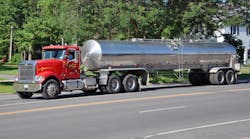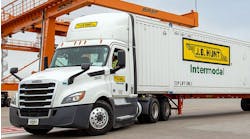It was a strong December for the used truck sector, as used Class 8 volume increased 11% over November and 27% year-over-year, according to ACT Research’s “The State of the Industry: U.S. Classes 3-8 Used Trucks Report.” Despite 2020 being marked by a crippling global pandemic, used Class 8 trucks volumes eclipsed 2019 numbers by 25%.
This report, which samples data from the major North American truck manufacturers, found that year-to-date, average price and tractor age dropped 8%, while miles were down 4%. While no one could predict the devastation of COVID-19, the used truck trends were in line with what the trucking analyst firm anticipated.
“Months before COVID reared its ugly head, we were expecting the cooling that started mid-year in 2019 to continue into 2020. The market was overheated and in need of a much-deserved breather,” said Steve Tam, vice president at ACT Research. “While we are not yet officially forecasting used truck values, we called for full-year pricing to be down between 5% and 10%. December’s preliminary reading of -8% falls squarely in that range.”
Tam said all three used channels grew, with retail seeing weaker growth than wholesale and auction. “Miles and age continue to support higher pricing, falling 8% and 9%, respectively, compared to 2019,” he noted.
The leading truck OEM, Daimler Trucks North America, expects a more steady 2021 for the used market.
“Prices are on the rise for used trucks right now,” said Mary Aufdemberg, president and general manager of Daimler Trucks Remarketing. “Inventories are decreasing in the marketplace, but we do expect supply to keep coming. [Looking] forward to next year, I think prices will continue to stabilize.”
It may be more difficult to find the right used truck for the right price in te first half of the year, though.
“Ultimately, I think demand will be a little stronger than supply, at least in the first half of the year going forward,” she said.
Surge in new truck orders
The new Class 8 tractor market is also poised for a strong run, with FTR Intel reporting November and December 2020 both topped 50,000 net orders. In April 2020, orders fell below 5,000 as factories shut down to prevent COVID-19 spread and the world itself seemed to stop turning.
“As the economy continues to improve, fleets are showing increasing confidence about business conditions in 2021,” said Don Ake, vice president of commercial vehicles for FTR. “Profits are more than sufficient to replace used trucks and freight growth is stimulating expansion demand. Put those dynamics together, and the industry is headed toward a robust year.”
Initial data from ACT’s “State of the Industry: NA Classes 5-8 Report” appear to back that up.
“To repurpose a phrase, commercial vehicle demand started 2020 like a lamb and left the year like a lion. At the start of 2021, the challenges for medium- and heavy-duty OEMs and suppliers are flipped 180 degrees from a year ago,” said Kenny Vieth, ACT Research’s president and senior analyst.
“Where the challenge a year ago was in winding down build rates to align production with tepid demand, the industry’s challenge today is to ramp-up as rapidly as possible to meet soaring demand.”
Fleets should be better positioned to handle the welcome reversal, as many experienced the record-setting 2018, reaching nearly half a million units, after weak sales the previous few years. According to FTR, Class 8 orders for 2020 hit 283,000.
“It seems that everyone is ordering in the Class 8 segment, but the tractor market is rising at a considerably more rapid clip, if against easier year-ago comparisons, than the vocational truck side of market,” Vieth said.
The versatility of the medium-duty market was able to meet consumers shifting to ecommerce during the pandemic, though Vieth wondered if that is sustainable.
“Order performance continues mixed across the three market components that ACT tracks, with truck orders benefiting from e-commerce demand and RVs enjoying a pandemic-related boost, although one wonders about the staying power of this phenomenon with vaccines arriving, while social distancing continues to weigh on school bus orders,” he said.
Vieth also cited a few other issues that could impact 2021: “The near-term ramp is not without challenges, however, and those include the global steel and silicon chip shortages, as well as ramping up during a pandemic.”




